A Handheld Multispectral Device for Assessing Leaf Nitrogen Concentrations in Maize
Abstract
Highlights
- A handheld multispectral device using the AS7265x sensor was successfully developed and validated.
- The use of multivariate statistical models (PLSR and PCR) significantly enhanced the accuracy of predicting leaf nitrogen concentration in maize.
- The device enabled rapid, non-destructive nitrogen estimation under real field conditions.
- The successful development and validation of the handheld device demonstrates the feasibility of integrating portable multispectral sensors into precision agriculture for effective on-site nutrient assessment.
- The improved prediction accuracy provided by the multivariate statistical models supports reliable nitrogen estimations, which can lead to more optimized nutrient management decisions.
- The device’s ability to conduct rapid, non-destructive measurements under field conditions facilitates timely interventions and supports sustainable agricultural practices.
Abstract
1. Introduction
2. Materials and Methods
2.1. Device Design and Construction
2.2. Calibration of the Optical System
2.3. Experimental Site and Design
2.4. Spectral Data Acquisition
2.5. Laboratory Analysis
2.6. Data Processing and Statistical Analysis
3. Results
3.1. Device Assembly and Calibration
3.2. Statistical Analysis
3.3. Spectral Analysis
3.4. Predictive Modelling and Validation
4. Discussion
5. Conclusions
Author Contributions
Funding
Institutional Review Board Statement
Informed Consent Statement
Data Availability Statement
Acknowledgments
Conflicts of Interest
References
- Cândido, B.; Mindala, U.; Ebrahimy, H.; Zhang, Z.; Kallenbach, R. Integrating Proximal and Remote Sensing with Machine Learning for Pasture Biomass Estimation. Sensors 2025, 25, 1987. [Google Scholar] [CrossRef] [PubMed]
- Laveglia, S.; Altieri, G.; Genovese, F.; Matera, A.; Di Renzo, G.C. Advances in Sustainable Crop Management: Integrating Precision Agriculture and Proximal Sensing. AgriEngineering 2024, 6, 3084–3120. [Google Scholar] [CrossRef]
- Wang, X.; Miao, Y.; Dong, R.; Zha, H.; Xia, T.; Chen, Z.; Kusnierek, K.; Mi, G.; Sun, H.; Li, M. Machine learning-based in-season nitrogen status diagnosis and side-dress nitrogen recommendation for corn. Eur. J. Agron. 2021, 123, 126193. [Google Scholar] [CrossRef]
- Song, D.; Qiao, L.; Gao, D.; Li, S.; Li, M.; Sun, H.; Ma, J. Development of crop chlorophyll detector based on a type of interference filter optical sensor. Comput. Electron. Agric. 2021, 187, 106260. [Google Scholar] [CrossRef]
- Habibullah, M.; Mohebian, M.R.; Soolanayakanahally, R.; Wahid, K.A.; Dinh, A. A Cost-Effective and Portable Optical Sensor System to Estimate Leaf Nitrogen and Water Contents in Crops. Sensors 2020, 20, 1449. [Google Scholar] [CrossRef]
- Leon-Salas, W.D.; Rajendran, J.; Vizcardo, M.A.; Postigo-Malaga, M. Measuring Photosynthetically Active Radiation with a Multi-Channel Integrated Spectral Sensor. In Proceedings of the 2021 IEEE International Symposium on Circuits and Systems (ISCAS), Daegu, Republic of Korea, 22–28 May 2021; pp. 1–5. [Google Scholar] [CrossRef]
- Stevens, J.D.; Murray, D.; Diepeveen, D.; Toohey, D. Adaptalight: An Inexpensive PAR Sensor System for Daylight Harvesting in a Micro Indoor Smart Hydroponic System. Horticulturae 2022, 8, 105. [Google Scholar] [CrossRef]
- Cilia, C.; Panigada, C.; Rossini, M.; Meroni, M.; Busetto, L.; Amaducci, S.; Boschetti, M.; Picchi, V.; Colombo, R. Nitrogen Status Assessment for Variable Rate Fertilization in Maize through Hyperspectral Imagery. Remote Sens. 2014, 6, 6549–6565. [Google Scholar] [CrossRef]
- Ma, J.; Zheng, B.; He, Y. Applications of a Hyperspectral Imaging System Used to Estimate Wheat Grain Protein: A Review. Front. Plant Sci. 2022, 13, 837200. [Google Scholar] [CrossRef] [PubMed]
- Peng, Y.; Zhang, M.; Xu, Z.; Yang, T.; Su, Y.; Zhou, T.; Wang, H.; Wang, Y.; Lin, Y. Estimation of leaf nutrition status in degraded vegetation based on field survey and hyperspectral data. Sci. Rep. 2020, 10, 4361. [Google Scholar] [CrossRef]
- Anas, M.; Liao, F.; Verma, K.K.; Sarwar, M.A.; Mahmood, A.; Chen, Z.-L.; Li, Q.; Zeng, X.-P.; Liu, Y.; Li, Y.-R. Fate of nitrogen in agriculture and environment: Agronomic, eco-physiological and molecular approaches to improve nitrogen use efficiency. Biol. Res. 2020, 53, 47. [Google Scholar] [CrossRef]
- Berger, K.; Verrelst, J.; Féret, J.-B.; Wang, Z.; Wocher, M.; Strathmann, M.; Danner, M.; Mauser, W.; Hank, T. Crop nitrogen monitoring: Recent progress and principal developments in the context of imaging spectroscopy missions. Remote Sens. Environ. 2020, 242, 111758. [Google Scholar] [CrossRef] [PubMed]
- Curran, P.J. Remote sensing of foliar chemistry. Remote Sens. Environ. 1989, 30, 271–278. [Google Scholar] [CrossRef]
- Elvidge, C.D. Visible and near infrared reflectance characteristics of dry plant materials. Int. J. Remote Sens. 1990, 11, 1775–1795. [Google Scholar] [CrossRef]
- Min, M.; Lee, W.S. Determination of Significant Wavelengths and Prediction of Nitrogen Content for Citrus. Trans. ASAE 2005, 48, 455–461. [Google Scholar] [CrossRef]
- Bi, K.; Niu, Z.; Xiao, S.; Bai, J.; Sun, G.; Wang, J.; Han, Z.; Gao, S. Non-Destructive Monitoring of Maize Nitrogen Concentration Using a Hyperspectral LiDAR: An Evaluation from Leaf-Level to Plant-Level. Remote Sens. 2021, 13, 5025. [Google Scholar] [CrossRef]
- Wang, J.; Shen, C.; Liu, N.; Jin, X.; Fan, X.; Dong, C.; Xu, Y. Non-Destructive Evaluation of the Leaf Nitrogen Concentration by In-Field Visible/Near-Infrared Spectroscopy in Pear Orchards. Sensors 2017, 17, 538. [Google Scholar] [CrossRef]
- Kipp, S.; Mistele, B.; Schmidhalter, U. The performance of active spectral reflectance sensors as influenced by measuring distance, device temperature and light intensity. Comput. Electron. Agric. 2014, 100, 24–33. [Google Scholar] [CrossRef]
- Poh, A.H.; Jamaludin, M.F.; Fadzallah, I.A.; Nik Ibrahim, N.M.J.; Yusof, F.; Adikan, F.; Moghavvemi, M. Diffuse reflectance spectroscopic analysis of barium sulphate as a reflection standard within 173–2500 nm: From pure to sintered form. J. Near Infrared Spectrosc. 2019, 27, 393–401. [Google Scholar] [CrossRef]
- Martins, R.N.; Pinto, F.D.A.D.C.; Moura, A.D.D.; Siqueira, W.D.C.; Villar, F.M.D.M. Nitrogen variable rate fertilization in corn crop prescribed by optical sensor. J. Plant Nutr. 2020, 43, 1681–1688. [Google Scholar] [CrossRef]
- Kirk, P.L. Kjeldahl Method for Total Nitrogen. Anal. Chem. 1950, 22, 354–358. [Google Scholar] [CrossRef]
- Lee, M.H. Data Analysis with RStudio: An Easygoing Introduction by Franz Kronthaler and Silke Zöllner Berlin, Germany: Springer-Verlag GmbH, DE, 2021. pp. 131. Biometrics 2021, 77, 1502–1503. [Google Scholar] [CrossRef]
- Lehnert, L.W.; Meyer, H.; Obermeier, W.A.; Silva, B.; Regeling, B.; Bendix, J. Hyperspectral Data Analysis in R: The hsdar Package. J. Stat. Softw. 2019, 89, 1–23. [Google Scholar] [CrossRef]
- Kumar, A. Pre-processing and Modelling using Caret Package in R. Int. J. Comput. Appl. 2018, 181, 39–42. [Google Scholar] [CrossRef]
- Ripley, B.; Venables, B.; Bates, D.M.; Hornik, K.; Gebhardt, A.; Firth, D. Support Functions and Datasets for Venables and Ripley’s MASS. Version 7.3-61. Available online: https://cran.r-project.org/web/packages/MASS/MASS.pdf (accessed on 28 August 2024).
- Zhao, X.; Peng, Y.; Li, Y.; Wang, Y.; Li, Y.; Chen, Y. Intelligent micro flight sensing system for detecting the internal and external quality of apples on the tree. Comput. Electron. Agric. 2023, 204, 107571. [Google Scholar] [CrossRef]
- Jiang, Y.; Zhang, D.; Yang, L.; Cui, T.; He, X.; Wu, D.; Dong, J.; Li, C.; Xing, S. Design and experiment of non-destructive testing system for moisture content of in-situ maize ear kernels based on VIS-NIR. J. Food Compos. Anal. 2024, 133, 106369. [Google Scholar] [CrossRef]
- Ram, K.V.; Raj, A.D.; Patel, K.H. Effect of Nitrogen, Phosphorus and Potassium on Yield, Quality, Nutrient Content and Uptake on Hybrid Maize (Zea mays L.). Agric. Sci. Digest. 2022, 43, 295–300. [Google Scholar] [CrossRef]
- Széles, A.V.; Megyes, A.; Nagy, J. Irrigation and nitrogen effects on the leaf chlorophyll content and grain yield of maize in different crop years. Agric. Water Manag. 2012, 107, 133–144. [Google Scholar] [CrossRef]
- Ványiné, A.S. Effect of nitrogen doses on the chlorophyll concentration, yield and protein content of different genotype maize hybrids in Hungary. Afr. J. Agric. Res. 2012, 7, 2546–2552. [Google Scholar] [CrossRef]
- Stefanello, L.O.; Schwalbert, R.; Schwalbert, R.A.; Drescher, G.L.; De Conti, L.; Pott, L.P.; Tassinari, A.; Kulmann, M.S.D.S.; Da Silva, I.C.B.; Brunetto, G. Ideal nitrogen concentration in leaves for the production of high-quality grapes cv ‘Alicante Bouschet’ (Vitis vinifera L.) subjected to modes of application and nitrogen doses. Eur. J. Agron. 2021, 123, 126200. [Google Scholar] [CrossRef]
- Yoder, B.J.; Pettigrew-Crosby, R.E. Predicting nitrogen and chlorophyll content and concentrations from reflectance spectra (400–2500 nm) at leaf and canopy scales. Remote Sens. Environ. 1995, 53, 199–211. [Google Scholar] [CrossRef]
- Clevers, J.G.P.W.; Gitelson, A.A. Remote estimation of crop and grass chlorophyll and nitrogen content using red-edge bands on Sentinel-2 and -3. Int. J. Appl. Earth Observ. Geoinf. 2013, 23, 344–351. [Google Scholar] [CrossRef]
- Chi, Y.X.; Ahmad, S.; Yang, K.J.; Fu, J.; Yang, L.; Zhou, X.B.; Zhu, H.D. Effects of nitrogen and water stress on the rehydration, endogenous hormonal regulation and yield of maize. J. Agron. Crop Sci. 2023, 209, 161–175. [Google Scholar] [CrossRef]
- Bausch, W.C.; Duke, H.R. Remote Sensing of Plant Nitrogen Status in Corn. Trans. ASAE 1996, 39, 1869–1875. [Google Scholar] [CrossRef]
- Uchino, H.; Watanabe, T.; Ramu, K.; Sahrawat, K.L.; Marimuthu, S.; Wani, S.P.; Ito, O. Calibrating Chlorophyll Meter (Spad-502) Reading by Specific Leaf Area for Estimating Leaf Nitrogen Concentration in Sweet Sorghum. J. Plant Nutr. 2013, 36, 1640–1646. [Google Scholar] [CrossRef]
- Guan, D.; Al-Kaisi, M.M.; Zhang, Y.; Duan, L.; Tan, W.; Zhang, M.; Li, Z. Tillage practices affect biomass and grain yield through regulating root growth, root-bleeding sap and nutrients uptake in summer maize. Field Crops Res. 2014, 157, 89–97. [Google Scholar] [CrossRef]
- Zhang, Q.; Ma, L.; Chen, X.; Lin, J.; Yin, C.; Yao, Q.; Lv, X.; Zhang, Z. Estimation of nitrogen in cotton leaves using different hyperspectral region data. Not. Bot. Horti Agrobot. Cluj-Napoca 2022, 50, 12595. [Google Scholar] [CrossRef]
- Yang, B.; Huang, X.; Yan, X.; Zhu, X.; Guo, W. A cost-effective on-site milk analyzer based on multispectral sensor. Comput. Electron. Agric. 2020, 179, 105823. [Google Scholar] [CrossRef]
- Meacham-Hensold, K.; Montes, C.M.; Wu, J.; Guan, K.; Fu, P.; Ainsworth, E.A.; Pederson, T.; Moore, C.E.; Brown, K.L.; Raines, C.; et al. High-throughput field phenotyping using hyperspectral reflectance and partial least squares regression (PLSR) reveals genetic modifications to photosynthetic capacity. Remote Sens. Environ. 2019, 231, 111176. [Google Scholar] [CrossRef]
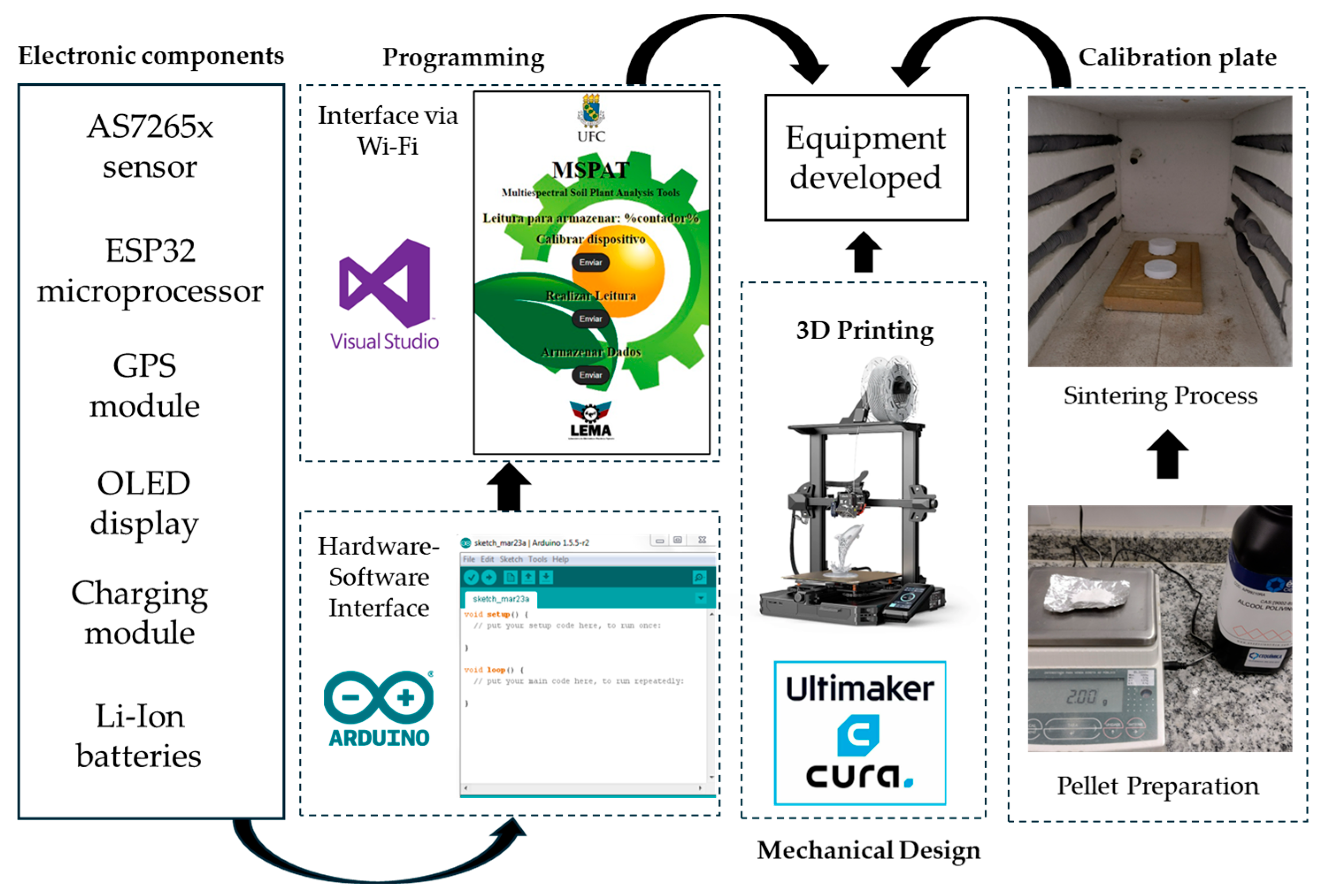

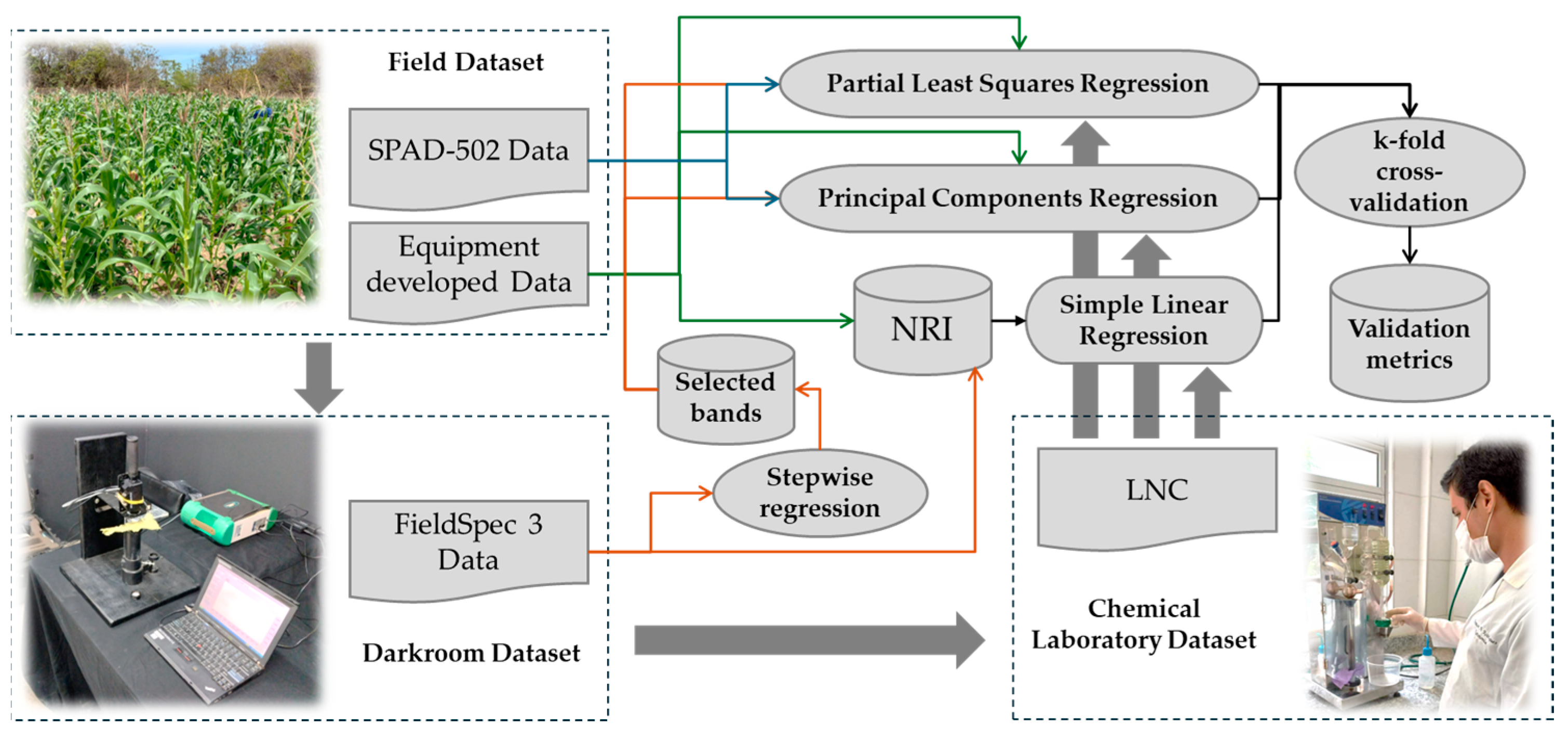
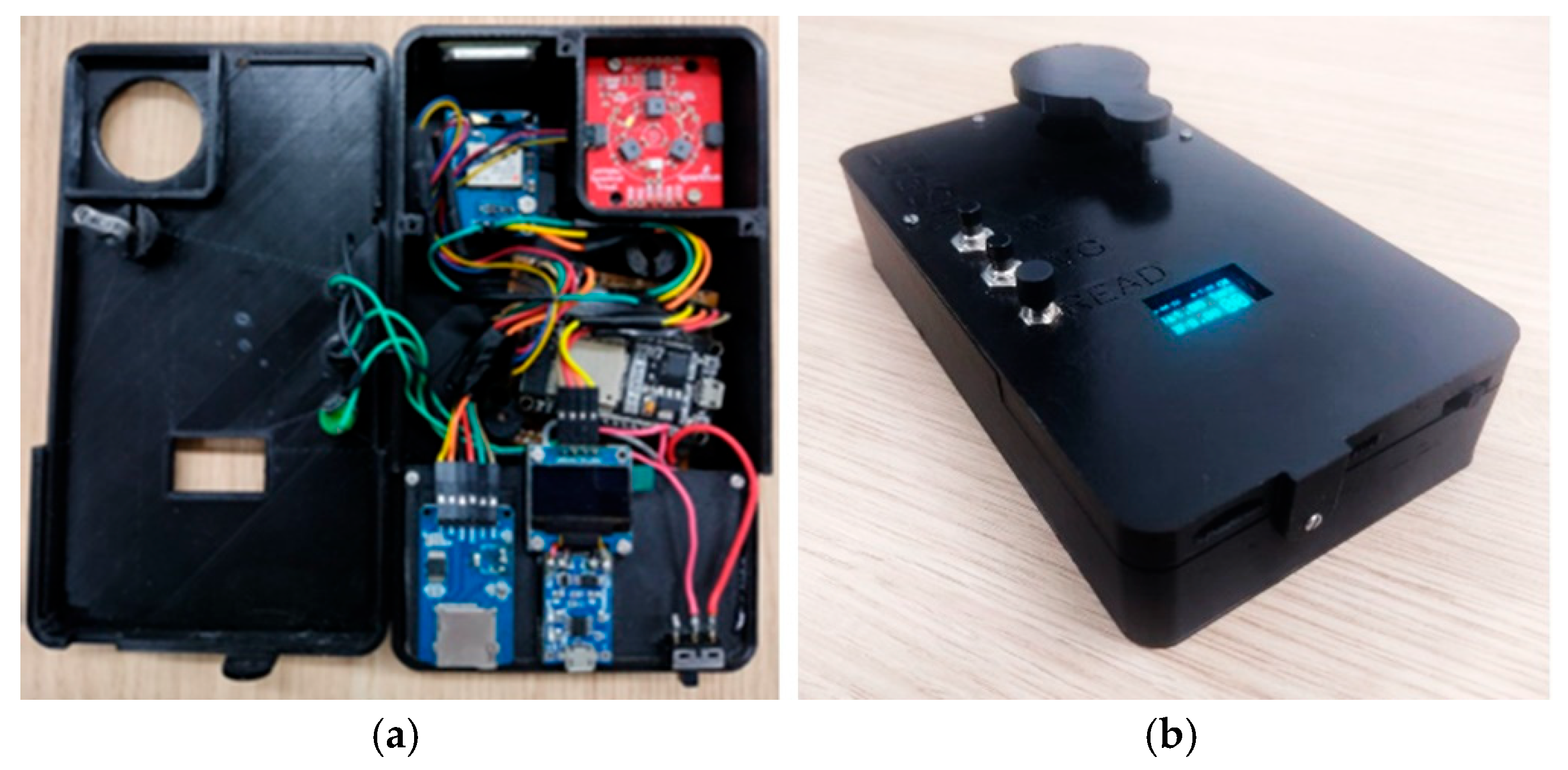



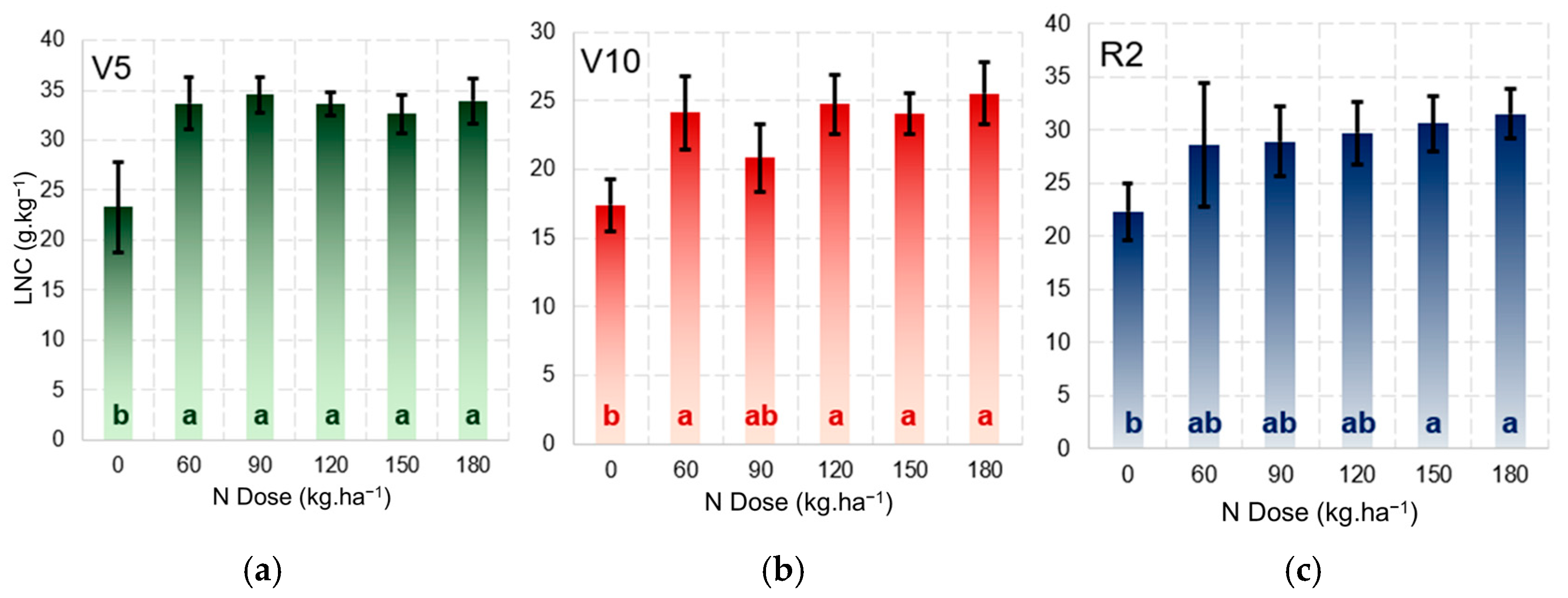
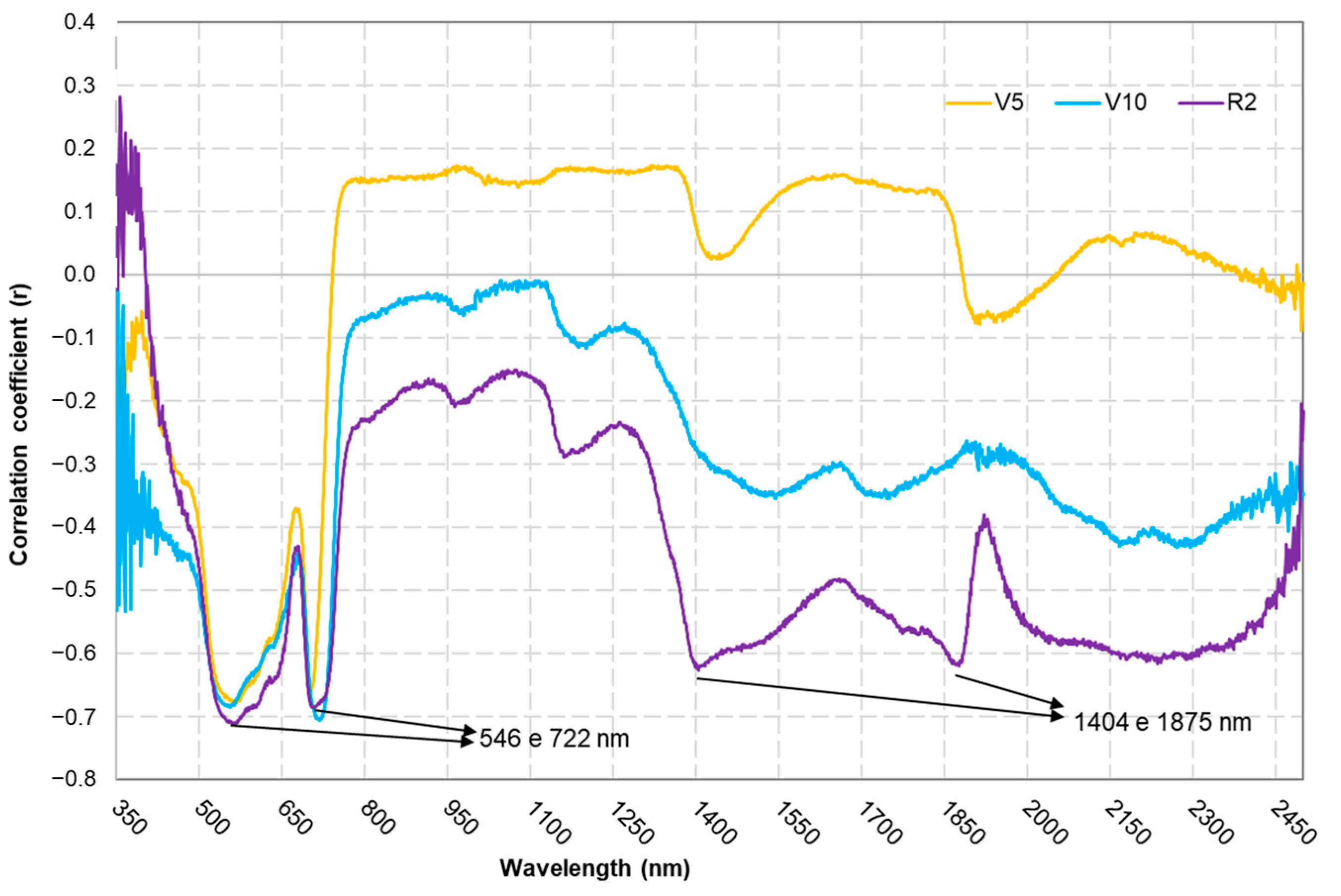





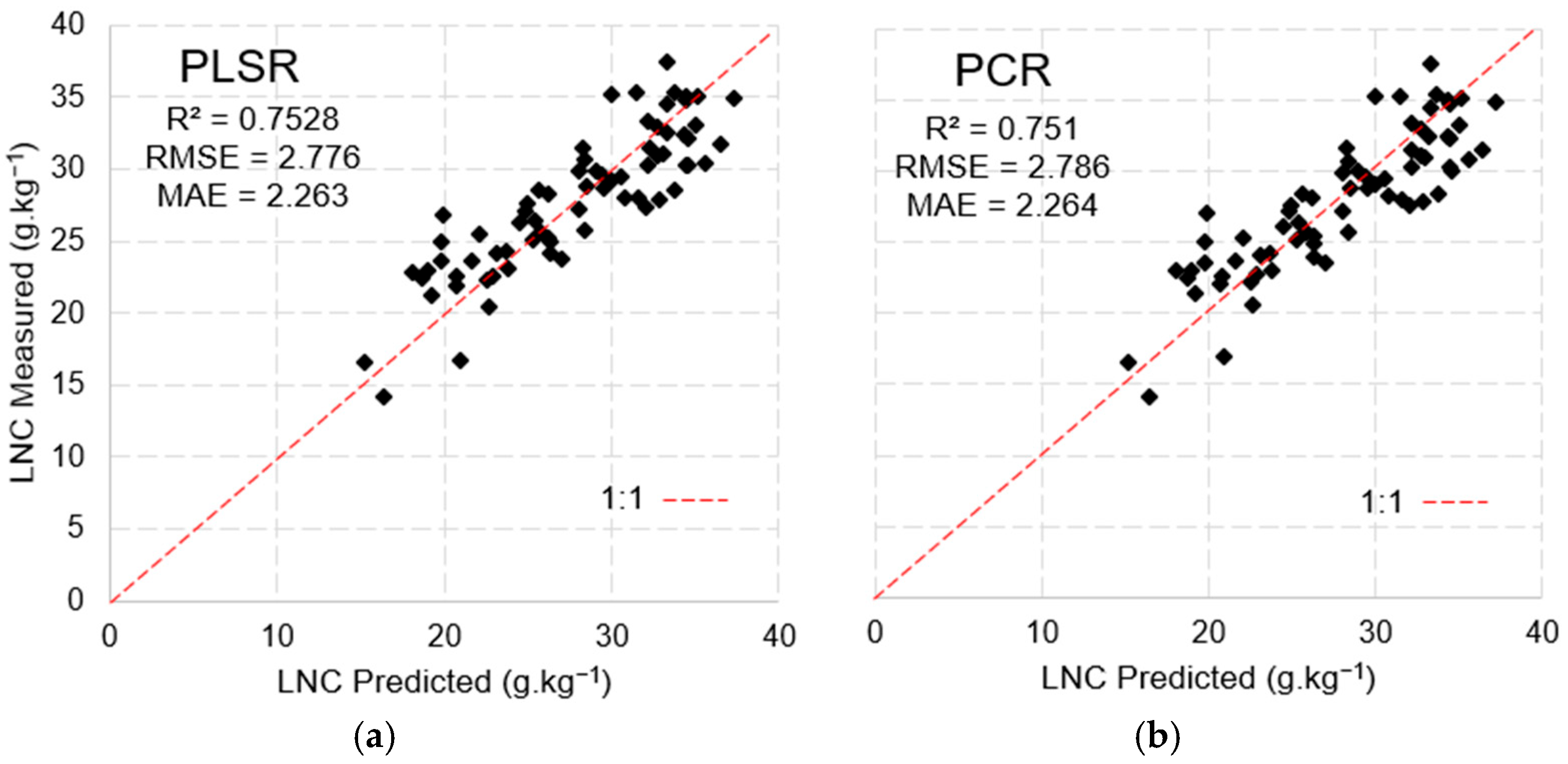
| Days After Planting (DAP) | Experimental Treatments | |||||
|---|---|---|---|---|---|---|
| N0 | N60 | N90 | N120 | N150 | N180 | |
| 0 | 0 | 30 | 30 | 30 | 30 | 30 |
| 14 | 0 | 30 | 60 | 60 | 90 | 90 |
| 28 | 0 | 0 | 0 | 30 | 30 | 30 |
| 42 | 0 | 0 | 0 | 0 | 0 | 30 |
| Total | 0 | 60 | 90 | 120 | 150 | 180 |
| Assortative Complex (cmolc/kg) | ||||||||||
|---|---|---|---|---|---|---|---|---|---|---|
| Ca2+ | Mg2+ | Na+ | K+ | H+ + Al3+ | Al3+ | S | T | V (%) | m (%) | PST |
| 1.55 | 1.03 | 0.22 | 0.19 | 0.66 | 0 | 3 | 3.6 | 82 | 0 | 6 |
| C (g/kg) | N (g/kg) | C/N | OM (g/kg) | P (mg/kg) | pH (Water) | EC (dS/m) | ||||
| 5.26 | 0.54 | 10 | 9.07 | 9 | 6.5 | 0.07 | ||||
| FieldSpec 3 | SPAD | MSPAT | |||||||
|---|---|---|---|---|---|---|---|---|---|
| Stage | R2 | RMSE | MAE | R2 | RMSE | MAE | R2 | RMSE | MAE |
| V5 | 0.7890 | 2.0361 | 1.6719 | 0.6710 | 2.5660 | 2.0629 | 0.6107 | 3.4144 | 3.0172 |
| V10 | 0.5870 | 2.5874 | 2.1179 | 0.7091 | 2.2530 | 1.7375 | 0.7935 | 2.2577 | 1.8279 |
| R2 | 0.6845 | 2.8562 | 2.6229 | 0.4231 | 3.6987 | 3.0395 | 0.6855 | 2.8664 | 2.4704 |
| FieldSpec 3 (Reflectance) | FieldSpec 3 (First Derivative) | MSPAT (Reflectance) | |||||||
|---|---|---|---|---|---|---|---|---|---|
| Bands | PCR | PLSR | Bands | PCR | PLSR | Bands | PCR | PLSR | |
| Model parameters | 364 nm | −246.11 | −310.61 | 543 nm | −14,642.64 | −18,476.88 | 410 nm | 133.35 | 132.47 |
| 369 nm | −636.74 | −655.29 | 657 nm | 19,950.06 | 9443.36 | 460 nm | −62.01 | −65.21 | |
| 374 nm | 430.83 | 501.34 | 660 nm | −14,339.63 | −6140.98 | 485 nm | 134.57 | 130.40 | |
| 388 nm | −412.56 | −328.38 | 995 nm | −15,891.36 | −20,518.20 | 535 nm | −133.07 | −124.83 | |
| 397 nm | 1015.84 | 931.40 | 1675 nm | −23,383.25 | −20,468.88 | 560 nm | −51.19 | −86.50 | |
| 557 nm | 1611.30 | −18.74 | 2155 nm | −9291.63 | −3923.69 | 585 nm | −56.85 | −21.36 | |
| 561 nm | −1727.78 | −78.68 | 2189 nm | −15,009.74 | −14,560.58 | 610 nm | 48.27 | 48.72 | |
| 735 nm | −87.52 | −67.73 | 2257 nm | 22,502.14 | 22,948.61 | 645 nm | −193.43 | −197.96 | |
| 2279 nm | −17,066.27 | −19,334.37 | 680 nm | −126.33 | −124.62 | ||||
| 2283 nm | −10,996.14 | −9975.65 | 705 nm | 124.30 | 133.04 | ||||
| 2374 nm | 5773.32 | 5767.96 | 730 nm | −61.85 | −62.01 | ||||
| 810 nm | 54.23 | 53.91 | |||||||
| Intercept | 61.96 | 59.74 | 40.80 | 41.57 | 42.95 | 42.29 | |||
| R2 | 0.808 | 0.781 | 0.826 | 0.882 | 0.751 | 0.753 | |||
| Number of factors | 8 | 6 | 10 | 6 | 11 | 9 | |||
Disclaimer/Publisher’s Note: The statements, opinions and data contained in all publications are solely those of the individual author(s) and contributor(s) and not of MDPI and/or the editor(s). MDPI and/or the editor(s) disclaim responsibility for any injury to people or property resulting from any ideas, methods, instructions or products referred to in the content. |
© 2025 by the authors. Licensee MDPI, Basel, Switzerland. This article is an open access article distributed under the terms and conditions of the Creative Commons Attribution (CC BY) license (https://creativecommons.org/licenses/by/4.0/).
Share and Cite
Nogueira, F.H.M.; dos Santos Teixeira, A.; Ribeiro, S.G.; Moreira, L.C.J.; da Rocha Neto, O.C.; Lopes, F.B.; Nogueira, R.E.F.Q. A Handheld Multispectral Device for Assessing Leaf Nitrogen Concentrations in Maize. Sensors 2025, 25, 3929. https://doi.org/10.3390/s25133929
Nogueira FHM, dos Santos Teixeira A, Ribeiro SG, Moreira LCJ, da Rocha Neto OC, Lopes FB, Nogueira REFQ. A Handheld Multispectral Device for Assessing Leaf Nitrogen Concentrations in Maize. Sensors. 2025; 25(13):3929. https://doi.org/10.3390/s25133929
Chicago/Turabian StyleNogueira, Felipe Hermínio Meireles, Adunias dos Santos Teixeira, Sharon Gomes Ribeiro, Luís Clênio Jario Moreira, Odílio Coimbra da Rocha Neto, Fernando Bezerra Lopes, and Ricardo Emílio Ferreira Quevedo Nogueira. 2025. "A Handheld Multispectral Device for Assessing Leaf Nitrogen Concentrations in Maize" Sensors 25, no. 13: 3929. https://doi.org/10.3390/s25133929
APA StyleNogueira, F. H. M., dos Santos Teixeira, A., Ribeiro, S. G., Moreira, L. C. J., da Rocha Neto, O. C., Lopes, F. B., & Nogueira, R. E. F. Q. (2025). A Handheld Multispectral Device for Assessing Leaf Nitrogen Concentrations in Maize. Sensors, 25(13), 3929. https://doi.org/10.3390/s25133929







